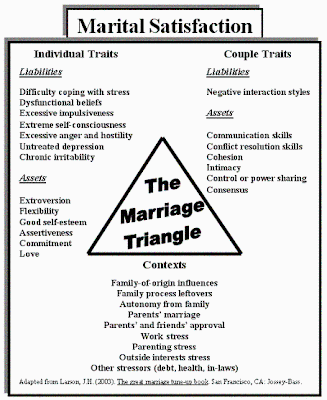As you prepare to enter into marriage, you will need to unscramble and negotiate all kinds of issues between you and your partner. Therefore, your first task is to see if you can unscramble the ten most important principles and ideas related to marriage preparation below. When you are done, Scroll down for the answers and to learn more about how you and your partner can prepare for this exciting event.
1. Three Stages of Marriage
According to researcher and practitioner Jeffrey Larson (2003), most marriages go through at least three general stages of development:
(1) romantic love;
(2) disillusionment and distraction
(3) dissolution, adjustment with resignation, or adjustment with contentment.
2. Marriage Myths
"Never go to bed angry at your spouse" or, "If my partner and I have a disagreement, our relationship is doomed!" are just two of the many myths that we can dispel before we ever get married. Sometimes, because we are tired and stressed, the best practice is to settle down and to get some needed rest before we deal with the issue the next morning. Other myths, according to Jeffry Larson (2003), include the following:
•"If my spouse loves me, he should instinctively know what I want and need to be happy,"
•"No matter how I behave, my spouse should love me simply because she is my spouse."
•"I can change my spouse by pointing out his inadequacies, errors, and other flaws."
•"I must feel better about my partner before I can change my behavior toward him."
•"Maintaining romantic love is the key to marital happiness over the life-span for most couples."
•"Marriage should always be a 50-50 partnership."
•"Marriage can fulfill all of my needs."
3. Marital Satisfaction
Larson and Holman (1994) have identified three general domains of important predictors of marital quality and stability (Note: Marital quality is defined by these authors as "a subjective evaluation of a couple's relationship." Marital stability is defined as "the status of the relationship as intact or nonintact [i.e., separated or divorced])." These domains are (from least predictive of marital quality and stability to most predictive): background and contextual factors, individual traits and behaviors, and couple interactional processes (i.e., traits). Larson calls these three domains the Marriage Triangle. According to Larson (2003), the Marriage Triangle (see below) highlights these three domains and focuses on the interactions between them.
4. Contexts or Environments
Contexts and environments are the settings in which individual and couple traits are developed. These influential contexts are placed at the bottom of the Marriage Triangle because they form the foundation of the development of individual and couple interactional traits. Larson (2003) divides these contexts into two general domains - personal contexts and relationship contexts. According to Larson, personal context characteristics include family-of-origin influences, such as the degree of love and unity in the family in which you grew up, the quality of your parents' marriage, and your degree of autonomy in your family-of-origin. Relationship context refers to the situation or environment in which your relationship currently exists. Examples of relationship context factors include support from in-laws, chronically unresolved marital problems, and stress caused by spending too much time or energy in raising children, dealing with financial problems, and so on.
5. Individual Traits
Individual traits that influence marital satisfaction or dissatisfaction include a person's personality, attitudes, and skills (Larson, 2003). Larson identifies difficulty coping with stress, dysfunctional beliefs (see Marriage Myths above), excessive impulsiveness (e.g., impulsive spending, obsessive compulsive behaviors, etc.), extreme self-consciousness, excessive anger and hostility, untreated depression, and chronic irritability as the major liabilities toward the achievement of marital satisfaction.
Conversely, Larson identifies extroversion (i.e., sociability), flexibility, good self-esteem, assertiveness, commitment, and an ability to love as the major assets toward the achievement of marital satisfaction.
6. Couple Traits
Couple traits that influence marital satisfaction and dissatisfaction include communication (see Happy Talk: Keep Talking Happy Talk) and conflict resolution skills (see 9 Important Skills for Every Relationship) and several other traits specifically pointed out by Larson (2003) that include the following:
Cohesion - time spent together compared with time spent apart that leads to a perception and feeling of emotional closeness.
Intimacy - the combination of self-disclosure, affection, sexual relations, and cohesion.
Control or power sharing - "the ability to influence another person to go in the direction you want" . When there is give-and-take and the power and control is equitable and shared, then a feeling of satisfaction generally occurs. When one spouse tends to "exercise too much power or control in decision making", then dissatisfaction can occur.
Consensus - "the degree of agreement you and your partner experience on a variety of marital issues such as proper behavior in public, religious matters, decision making, and displays of affection". Similarly, Larson states that "consensus can be realized in one of three ways in marriage:
(1) you accept and appreciate that you are already similar,
(2) you accept your differences without resentment or despair,
(3) you reach consensus through healthy conflict resolution"
7. Change Yourself First
Douglas A. Abbott (2003) shares three principles that can lead toward greater marital satisfaction:
(1) Change your behavior: Change first;
(2) Change your attitude; and,
(3) Change your heart. He also includes three ways to change ourselves first as follows:
Exercise patience with your partner's faults and annoying habits.
Drop the insistence that he or she must change
Take responsibility to change yourself and improve the relationship. The focus becomes you not your partner. You change first. Assuming there is good will and love between you and your spouse, your partner may then desire to also change. As you act in loving, forgiving, and benevolent ways, your spouse may reciprocate .
8. The Eighty-Twenty Rule
Dr. Abbott's (2003) 80-20 rule was developed from a story he read several years ago called "80 percent I love you, 20 percent I hate you." From this story he concluded, "to avoid over focusing on the spouse's negatives, you can train your mind to focus on the positives. Overlook the few small things(20 percent) that you don't like about your spouse and continually remind yourself of the 80 percent you like"
9. Change Your Heart
Dr. Abbott (2003) cites C. Terry Warner in his article who discussed the following about the need to change our hearts in our relationships:
A Change of Heart - "Without a change of heart whatever we do will carry the smell of manipulative, selfish, or fearful intent, and other people will readily discern it....The self-help movement that began in the latter half of the twentieth century suffers particularly from this flaw, for the personal and interpersonal skills it seeks to cultivate are almost always designed to get us more of what we think we want, rather than to bring about a change of heart". "To the extent that we can come to see others differently, we can undergo a fundamental change, a change in our being, a change of our emotions and attitudes, a change of heart" . "We do not control the timing of a change of heart. We make ourselves available for it by faithfully doing the right things for the right reasons; that much does lie within our control" . "There is no better means of promoting another person's change of heart than allowing our own heart to change"
10. Seek Marital Therapy
Most relationships "get stuck" at some point and they need a little help (sometimes a lot of help) to "get unstuck". Therefore, one of the best ways we can prepare for marriage is to overcome the stigma sometimes associated with seeking marital therapy. Couples who are proactive and who seek therapy early, before their relationship is falling apart, are wise.








.jpg)













